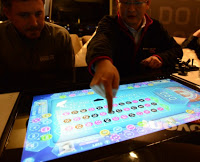Dismayed that family members are spread out over the house, each with a separate PC or tablet? Lenovo has something it believes will get them back together: a PC the size of a coffee table that works like a gigantic tablet and lets four people use it at once.
Lenovo Group Ltd., one of the world’s largest PC makers, is calling the IdeaCentre Horizon Table PC the first “interpersonal computer” – as opposed to a “personal computer.”
At first glance, it looks like a regular all-in-one machine in the vein of the iMac: It’s a 27-inch screen with the innards of a Windows 8 computer built into it, and it can stand up on a table.
But you can pick it up off the table, unhook the power cord and lay it flat for games of “Monopoly.” It’s big enough to fit four people around it, and the screen can respond to ten fingers touching it at the same time.
There’s more at the original article, but the implications for tabletop gaming are clear, and even alluded to in the article. Where monstrosities such as dedicated gaming tables have fallen flat in terms of finding a market, this device might actually have a chance. It’s going to start retailing this summer at $1,699, but doubtless that will come down in short order, and discounted prices will be had online as well.
Imagine something like that for playing Cataan. Or displaying a dungeon map, or battle grid with markers for characters and monsters, able to be manipulated in real time by tapping the screen. If this thing does catch on, it veritably screams for someone to put together an application to facilitate generic dungeon crawls, or even system-specific facilitators. Heck, right off the bat it could be used to display large flat image files, which could be good enough for battle-mat applications.
I’ll be interested to see whether this gets any traction. It’s a high price point, but there’s lots of potential there.










It may, perhaps, have a future in gaming, but kids today like their privacy too much. They're not interested in sharing their internet browsing with their parents.
I don't see this getting the "family" back together.
This would be awesome as a mapping tool in an RPG. The DM just brings up the appropriate map for the players with the appropriate data that they know and says "you are here" and off you go.
Would be very cool if you could also, for those D20 folks, connect it via network to a bunch of other tablets (the less costly ones maybe) which would be used by players as character sheets.
But then again, ain't nothing wrong with pencil and paper.
Getting closer to what I am predicting what will be the future form of gaming. The main issue with this, other than the price, is portability and battery life.
What will take off is a thin screen that you can unfold onto any surface. It will have a connector to interface with a tablet or hub that provides the computer.
Also note this article here http://reviews.cnet.com/desktops/lenovo-ideacentre-horizon-27/4505-3118_7-35561100.html which show a six sided dice that is able to interact with the screen.
The screen needs to be behind a separate replaceable, rigid sheet of cheap-ass plastic suspended away from the screen enough that you can't bend it enough to touch the screen. Then they need to make the screen register fingertouches on the plastic sheet.
Either that or make the screen able to withstand a 20lb weight striking it with a point and a 200lb weight resting against it for hours at a time.
Otherwise your $1700 table screen is gonna get busted almost immediately.
I guess what I'm saying is, I can spend $300 on a solid table and I expect it to last a few decades of wear. If I spend $1700 on a screen I expect it to last a few decades.
Second, I really don't understand why they don't allow for thousands of fingertip controls at once. We have the processing capability. That would allow for people to program relational fingertip commands like you see in smartphones with "push apart" and "pinch together" acting as zoom commands. You could have a pair of hands doing 5-finger relational fingertip commands and you're already at the maximum.
Third, Monopoly is such as terrible choice for PR purposes since it has such a deathmarch reputation. If nobody's getting together to play real Monopoly why would they shove around Monopoly pixels instead?
Fourth, 27" is enough for a tiny board game or card game but it's not enough for D&D. I know some people play on a coffee table or folding card table but I use a 54" (diagonally) wet-erase mat and it's just about right.
Sure you could zoom out to 50% and make 1" across figures into 1/2" across ones, and of course they're flat so they're harder to see. Animated icons and tooltip labels could help identify figures and features. But we still have the problem of this 19" x 19" screen that's supposed to fit ten people around it. You'd have a big table with this thing in the middle and people would have to reach and peer across at arms' length to use it.
For a size comparison, go ahead and get out a ruler and put your hands half a ruler farther, and square it out with your other arm. It's really about the size of a Monopoly board.
Finally, I don't see why it's also a computer. Just make it a monitor and connect it to your laptop via USB or HDMI.
Oh, man, for this and a copy of VASSAL and my wargaming dreams are come true…
No more setting up maps! No more sorting chits! No more unfortunate cat incidents! 😉